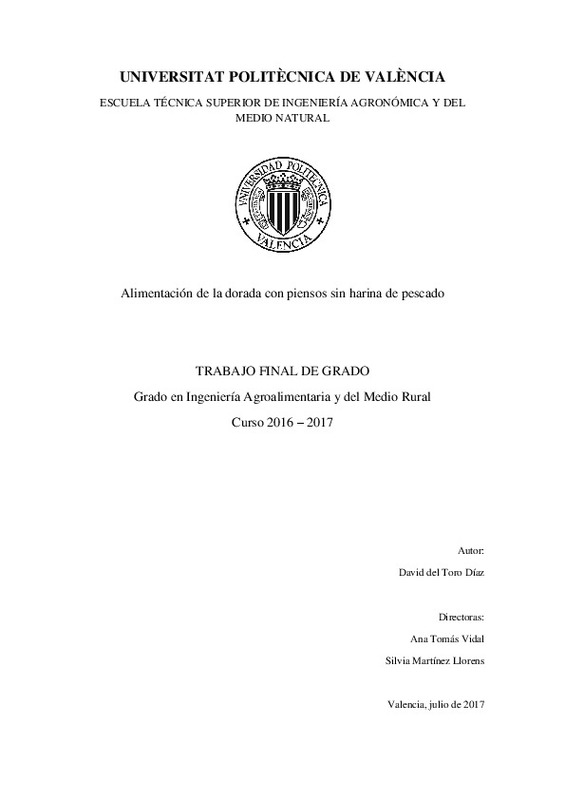|
Resumen:
|
[ES] La acuicultura está en continuo crecimiento, sin embargo, las harinas y los aceites de pescado
son un recurso que está en decadencia, es por ello que la industria se ha visto forzada a
investigar materias primas ...[+]
[ES] La acuicultura está en continuo crecimiento, sin embargo, las harinas y los aceites de pescado
son un recurso que está en decadencia, es por ello que la industria se ha visto forzada a
investigar materias primas alternativas para alimentar a los peces. En la actualidad se está
invirtiendo tiempo y esfuerzo en la investigación de fuentes de aceites y harinas vegetales y
animales, así como en los niveles óptimos que se deben incluir en la dieta de las diferentes
especies de peces.
El objetivo de este trabajo es valorar el efecto de la sustitución de la harina de pescado por una
mezcla de harinas animales y vegetales (harina de carne de cerdo ibérico, harina de soja, de
guisante y de girasol), en el crecimiento y parámetros nutritivos de la dorada (Sparus aurata).
Para ello, se ensayarán 5 piensos experimentales en los que la harina de pescado se sustituirá en
un 75, 90 y 100%. Habrá dos dietas con el 100% de sustitución (FM 0 y FM 0+), con la
diferencia que FM 0+ contendrá un 5% de alga. Se trabajará con juveniles de dorada (50g de
peso inicial). Al inicio y en cada muestreo, se pesarán todos los peces para luego estimar el peso
final (Pf) y la tasa de crecimiento instantáneo (TCI). Asimismo se calculará la tasa de
alimentación diaria (TAD) y el índice de conversión del alimento (ICA).
Diariamente, se realizarán una serie de controles para comprobar el correcto funcionamiento del
laboratorio: revisión general de la instalación, control de calidad del agua, control de
crecimiento, etc.; así como la alimentación de los peces dos veces al día.
Los controles de peso se realizarán cada 4 semanas y los peces serán alimentados hasta saciedad
aparente. Al inicio y final de cada experimento se sacrificarán los peces con un exceso de
esencia de clavo y se realizarán los análisis químicos: macronutrientes (siguiendo la
metodología descrita por la AOAC, 1990) y los aminoácidos totales (mediante cromatografía
líquida de alta resolución, HPLC) de los piensos fabricados y de los peces. De cada muestra, los
análisis se realizaran por triplicado.
[-]
[EN] Aquaculture is in continuous growth, however, fishmeal and fish oils are a resource that is in
decline, which is why the industry has been forced to investigate alternative raw materials to
feed the fish. At present, ...[+]
[EN] Aquaculture is in continuous growth, however, fishmeal and fish oils are a resource that is in
decline, which is why the industry has been forced to investigate alternative raw materials to
feed the fish. At present, time and effort are being invested in the research of sources of
vegetable and animal oils and flours as well as the optimum levels to be included in the diet of
different fish species.
The objective of this work is to evaluate the effect of substitution of fish meal for a mixture of
animal and vegetable flours (Iberic pig meal, soybean meal, pea and sunflower meal), growth
and nutritional parameters of the gilthead sea bream (Sparus aurata). To do this, 5 experimental
feeding stuffs will be tested in which the fish meal will be replaced in 75, 90 and 100%. There
will be two diets with 100% substitution (FM 0 and FM 0+); with the difference that FM 0+ will
contain 5% algae. It will work with juveniles of gilthead sea bream (50g of initial weight). At
the beginning and in each sampling, all the fish will be weighed and then the final weight (Fw)
and the specific growth rate (SGR) will be estimated. The feed intake ratio (FI) and the feed
conversion ratio (FCR) will also be calculated.
Daily, a series of controls will be carried out for the correct functioning of the laboratory:
general revision of the installation, water quality control, growth control, etc., as well as feeding
of the fish twice a day.
Weight checks will be performed every 4 weeks and the fish will be fed to apparent satiety. At
the beginning and at the end of each experiment the fish will be sacrificed with an excess of
clove oil and the chemical analyzes will be performed: macronutrients (following the
methodology described by AOAC, 1990) and total amino acids (by high performance liquid
chromatography, HPLC) of the manufactured feed and the fish. From each sample, all the
analyses were performed in triplicate.
[-]
|







